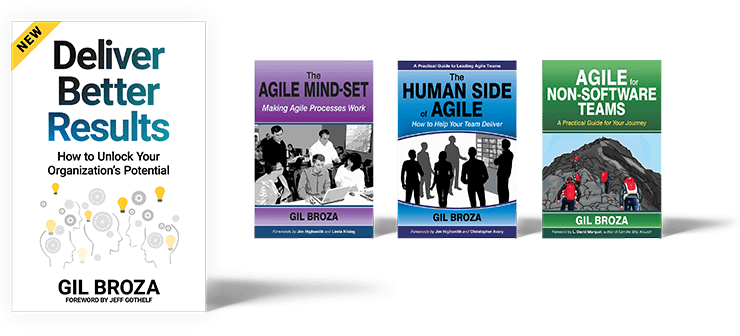Download the book’s supplementary resources
This page includes links to all the supplementary resources mentioned in the book, as well as any additions since the book came out. Feel free to download each and every one! Just right-click and choose “Save As…”.
Chapter 2, Consider How Agile Differs from Your Current Way of Working
Intentional Mind-Set Poster — Use this colorful, detailed visual of how mind-set bridges “why” and “how.” It also shows the key steps for designing a winning way of working.
Chapter 4, Determine Where You’ll Try Agile for the First Time
Chartering Checklist — Chapter 4 guides you to frame the work, an activity also known as chartering. Even if you’re not setting out to try a new way of working, you’ll find it extremely valuable to charter your initiatives before launching them. Doing so will align them with corporate strategy and themes, increase buy-in and excitement, and simplify governance. Here are the elements Gil Broza likes to include in a charter, using the more-formal terminology you’re likely to encounter in other management literature.
Chapter 6, Prepare for the Journey
Change Leadership: Preparation Questions — Whether an upcoming change is an experiment or a necessity, certain preparations can help reduce the inevitable performance dip and compress the time to successful integration of the change. If you’re part of leading that change, this checklist will help you ensure that you’ve covered all the bases.
Considerations for Choosing Your Agile Coach — Great coaches minimize the headache and risk involved in an Agile transformation. That’s an uncommon specialization, so choosing the right coach for you can be tricky. Use this checklist to assess your candidates.
Chapter 7, Learn Enough About Agile Principles to Get Started
Gil Broza’s Process for Effective Feedback Requests — When you operate with the Agile mind-set, you constantly seek feedback. Use Gil’s simple process to receive useful feedback from people and, along the way, strengthen your relationship with them.
Chapter 8, Design Your Initial Way of Working
Tips for an Effective Daily Standup / Touchpoint — Your Agile team will benefit from having a daily or near-daily check-in for both micro-planning and keeping the work moving. You can have a fruitful, valuable meeting by applying these tips, which include the what, why, and who, along with teamwork-friendly process options and ways to handle common problems and red flags.
10 Team Design Criteria Worksheet (newer version than what’s in the book) — Use Gil’s 10 criteria for team design as part of the initial experiment — and anytime you put together an Agile team.
Chapter 9, Support the Team During the First Few Months
Collaboration Etiquette Posters (for the A4 format click here) – Increase team member collaboration with these friendly, comics-style posters of the do’s and don’ts of working together.
How to Have One-on-One Meetings that Matter — Employee-manager meetings, known as “One-on-Ones,” must take place regularly. Whether you are an employee or a manager, use Gil’s guidelines for conducting effective one-on-one meetings that support growth and build trust.


